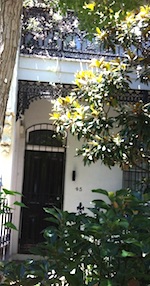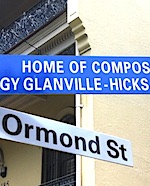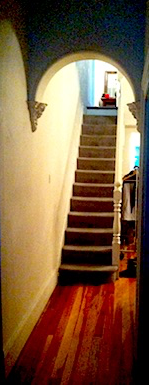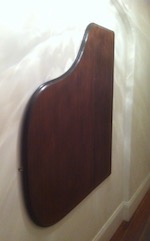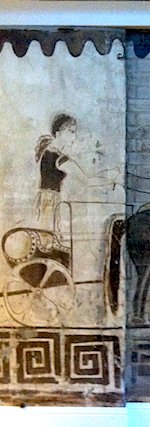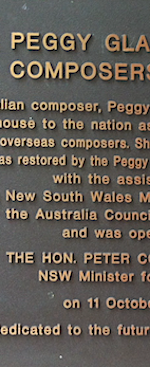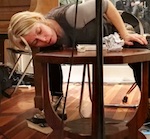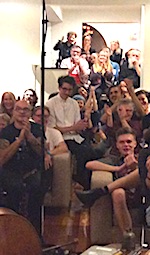 | |||||||

|
the peggy glanville-hicks residency 2017 composer in residence jon rose |
|
"A Larrikin par excellence. Jon Rose is not just a musician. He's an artist (and educator, innovator, inventor, writer) whose work flows across different media and art forms: improvisation, composition, performance, installations, multimedia, political art, and more. With enormous energy and originality, well-honed organisational and practical skills, good humour, healthy irreverence, and a constant stream of ideas, he moves freely between and over the fences we build between art forms, stopping along the way to play them." The residency at the Peggy Glanville-Hicks House, in addition to allowing time and space for composition, offered me the chance to create a regular series of music and conversation. Each event was recorded, usually for Stephen Adams' ABC podcast New Waves (Stephen's commitment to the series was outstanding). I started every Evenings@Peggy's with an acknowledgement of and respect for the Gadigal people of the Eora nation, on whose land we were assembled. This might have seemed like an unnecessary step into the politically correct arena by some who know me, but I really meant it. The criminality of Sydney real estate, which has now reached obscene proportions, was the base ingredient of white settlement. Quite simply, we stole the land. An acknowledgement of history costs nothing; ignoring history continues to keep us hooked on the end of the insecure colonial rod where we flounder today. This sense of illegitimacy pervades every aspect of Australian culture. Even the bright lights and general vacuity of a festival like Vivid, or populist Italian opera on the harbourside, or the new year's eve fireworks at a cost of $7 million for 12 minutes of wow do little to hide the dark waters beside which we sit. I ended each Evening@Peggy's with a call for more people to donate their houses to the nation like Peggy for use as music generators, instead of leaving the property to their boring children! One key part of my residency was to research, prepare, and compose Singing the Sydney Harbour Bridge for choir, live bridge sounds, and a reincarnation of the Wallaga Lake Gumleaf Band. At the bridge opening in 1932, this Aboriginal gumleaf band marched over the Bridge and off it into almost total obscurity. Akin to the traditional jazz of Australia, this popular music of the time has nonetheless been disappeared from the official history of Sydney and its Bridge. I proposed that Gumbaynggir elder and gumleaf virtuoso Roseina Boston would join us to perform a reconstruction of this previously popular music. I'm disappointed to say that even with a Noonuccal Nuugi director at the helm of the Sydney Festival, this project was not able to be realised. Click here to download the PDF of The Sydney Harbour Bridge Proposal Fortunately, working in collaboration with another species altogether, Cracticus nigrogularis (the pied butcherbird), and with my partner Hollis Taylor's detailed transcriptions and research of this feathered chorister's extraordinary music yielded a much better set of results. Together we have been creating a portfolio of compositions based on the recordings of these birds for a wide variety of instruments and situations. 1. The creation of a portfolio of works (joint compositions by Taylor and Rose) based on the transcriptions by Hollis Taylor of pied butcherbird songs: Trephina Ridge for string quartet and field recording (Kronos) Bye bye Blackbird for String Quartet and field recording Absolute Bird: Concerto for recorder and orchestra (Genevieve Lacy and The Adelaide Symphony Orchestra) and field recordings Owen Springs Reserve 2014 for vibraphone and field recording (Claire Edwardes) Owen Springs Reserve 2016 for vibraphone and field recording (Claire Edwardes) Hugh River 2016 for voice and organ and field recording (Jane Sheldon) Trephina Ridges Music Camp 2016 for two clarinets and field recording (Margery Smith & Jason Noble) Other major works composed and collated at the PGH House: Ballast for piano and interactive electronics (Zubin Kanga) Habit is the ballast that chains the dog to his vomit - Sam Beckett Archive for solo violin punctuated with audio samples from self-built experimental string instruments (The Relative Violins 1977-2017) Singing the Sydney Harbour Bridge For The Song Company, Roseina Boston (Aboriginal gumleaf band reconstruction), and interactive live bridge sounds. Project ready, scores written, technology designed ...Sydney Festival not interested; Vivid Festival not interested. As is quite common with the unimaginative in cultural power in Sydney, you can bring horses to water but you cannot make them drink. Video extract of choir and bridge sounds only here. Ensemble compositions Taken from the concerts at The Rosenberg Museum: THE MUSEUM GOES LIVE 2016 Music in a time of Dysfunction 1. Ensemble Offspring (mix and cut for ABC Radio 'New Waves' podcast) Music in a time of Dysfunction 2. Ensemble Offspring (mix and cut for ABC Radio 'New Waves' podcast) The Coffin. Jon Rose (mix and cut for ABC Radio) The Gamble. Jon Rose (mix and cut for ABC Radio) Entropy. Jon Rose (mix and cut for ABC Radio) The Rosenberg Chronicles. New radiophonic work by Jon Rose (Deutschland Radio) Preparation of recordings for SoundCloud: The Abandoned Organ 2007. preparation for NOWnow Festival Sydney 2017. Dueling Banjos and Banjo Duality Sydney studio recording 2004 Nimmersatt. Nimmersatt @ Cafe Oto 2016, London Palimpolin2 Violin Solo @ Tectonics Festival 2016, Glasgow 2016 2. The hosting and arranging of Evenings@Peggy's, a series of concerts with featured artists, interviews with Stephen Adams of ABC FM on New Waves Podcast, and public discussion: Featured Musicians: 3/4/2017 Jim Denley; 17/4/2017 Lisa Moore and Wayne Stuart; 27/4/2017 Hospital Hill Label CD release; 1/5/2017 Clayton Thomas; 29/5/2017 Colin Bright and Nich Polovineo; 10/6/2017 Eugene Ughetti; 19/6/2017 Gabriella Smart; 3/7/2017 Hollis Taylor with Claire Edwardes, Jason Noble, Margery Smith; 31/7/2017 Ben Ward, Jack Ward, Freya Schack-Arnott, Jon Rose; 4/9/2017 Vanessa Tomlinson; 16/10/2017 Zubin Kanga and Jane Sheldon; 13/11/2017 Mary Rapp and Amanda Stewart; 20/11/2017 Chris Abrahams and Jon Rose; 18/12/2017 Julia Reidy. The Peggy Glanville-Hicks House is a standard terrace abode with an extension downstairs consisting of a music room that houses a piano. When we first arrived, I looked forward to booking a number of pianists to exploit the extraordinary sonic qualities of the Stuart Grand (which includes extra notes at the top and bottom of the register, plus a unique fourth pedal that brings the action closer to the strings). However, to our surprise we discovered that the settlement of a drawn-out divorce meant that the piano was moving to New Zealand within a few weeks after the start of the residency. To the rescue came Mary Jo Capps (of Musica Viva), who procured another piano...actually smaller and more suitable to the size of the space than the monster Stuart. We bought some extra chairs, and I set about 'Evenings@Peggy's'. Because it is illegal to hold public concerts in Sydney without the necessary nonsense recently cooked up by lawyers and bureaucrats, I decided on a model that was not a public concert but a private gathering; entrance was free or by donation and registration through email; fees to musicians were paid for by the ABC or myself; the music was concentrated into 35-40 minutes which was followed by 30-40 minutes of interview and debate; there was a minimum of amplification and a concentration on acoustic; after-event drinks and conversation wrapped up by 9pm, so the neighbours could not complain. Amazement, the interviews and debates went on much longer than envisaged; a public debating contemporary music in Sydney for more than 5 minutes? Well, that was unexpected. Over the residency there were 14 evenings in total, the minimum audience was 40, the maximum was 80. Some evenings attracted such interest that we had to set a limit, turning latecomers away. The layout of the rooms downstairs enabled seating and the good audibility of even the quietest music. The main takeaway I have from organising this series is that it is possible to generate a specific community around and for unpopular music which does not involve minor celebrity appearances to generate an audience. Community is not always a valued commodity in Sydney, where musicians are often disorganised into disparate groups that have little to do with each other, so I was surprised that it was possible to create a small but enthusiastic new music community at this venue comparatively quickly - once there is a focus. All of which led me to the idea of calling for a meeting at the house that might go some way towards considering what may be done to improve the state of new music in Sydney. I invited a variety of musicians who would consider themselves part of new music, experimental, explorative, improvised, etc. The original list included composer Brett Dean, who initially accepted but then declined for reasons of health. A transcript of the meeting is available further down, but my basic idea was proposed as follows: I'd like to propose 40 musician houses like the Peggy Glanville-Hicks House across a town the size of Sydney. The musician/composer/sound artist/whatever would be responsible for improving the music in that area, and also responsible for the sonic ecology. The local council is responsible for the road signs, the lights, the sewage, the parks ...they should also be responsible for the sound of their neighbourhood and employ a musician to fix it. It would be a job contract for a year and the animateur would live there and work in the community, transforming the culture in a continual, communal, incremental way, a way that a once-a-year festival does not. The council would offer a building that could also double as a small venue, forgo rates, fix the place up if it needs work; the Australia Council would pay a year's stipend to keep the musician employed. Compared to the egregious amounts of money that keeps the Opera House going, this is pocket money, and it would cover the whole of Sydney with a population of 5 million. If an individual musician such as me goes knocking on the door of a local council with such an idea, the chances are they would not even give me the time of day. This is a job for the Australia Council. Ozco has the clout to make local councils listen to the argument at the very least. 3. Meeting of Minds round table discussion at PGH House: The state of New Music and what to do about it. 13/10/2017. Stephen Adams (composer and ABC broadcaster, New Waves), Elaine Chia (CEO, Angel Place), Jim Denley (musician and organiser of West Head project, Machine for Making Sense), Andrée Greenwell (composer, organiser of Green Room Music, teacher), Cat Hope (composer, bass player, leader of Decibel, academic), Zubin Kanga (pianist, member of Ensemble Offspring), Lisa McCowage (clarinetist and co-organiser of La La La), Kaylie Melville (Speak Percussion and New Music Network), Damien Ricketson (composer, former co-artistic director of Ensemble Offspring, and academic), Freya Schack-Arnott (cellist, co-organiser of Opus Now), David Sharpe (strategic and business adviser for creative industries), Gabriella Smart (pianist, head of Sound Stream), Clayton Thomas (double bass player and organiser of the NOWnow festival and series), Erkki Veltheim (violinist, composer), and Paul Mason - (observer and head of music at Ozco). PDF Transcript of meeting available here1, here2, here3, on Crikey's DAILY REVIEW. And in case Apple is screwing with your 'safari' software, here is a PDF of the complete Meeting of Minds In addition to the above, at Peggy's there was also a hosting of workshops, meetings, rehearsals, mentoring, and public engagement with amongst others: Ben Ward, Jane Sheldon, Stephen Jones, The Song Company and Antony Pitts, Chris Corsanno, John Gillies, Jenny Eriksson, Robbie Avenaim, Keyna Wilking, Freya Schack-Arnott, Jack Ward, Michela Davies, Ben Ward, Jane Sheldon, Catherine Benz, Stephen Jones, Jenny Eriksson, Robbie Avenaim, Sarah Thompson. The paradigm of setting up the Peggy Glanville-Hicks House as an incubator for the experience of music, as opposed to being just a retreat for the composer to write their symphonies or whatever, is one that deals specifically with the time and place in which we live. Peggy had no way of knowing what was going to happen in the 21st century, but I believe she would have taken on the new set of problems with gusto. Other musicians in post-war history may have had the luxury and privilege of conceiving music in perfect isolation (especially in Europe), but after the disemboweling and devaluing of music in the digital age, the onus of creating the experience of live music has never been more urgent in the hear and now. Here is my Peggy Glanville-Hicks Address from 2007 - it points to where we are now. THANK YOU, PEGGY! |
 |
